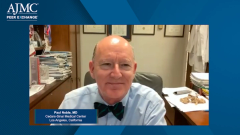
Treating ILD During the COVID-19 Pandemic
Daniel Culver, DO, details how COVID-19 has impacted the treatment of ILD.
Episodes in this series

Ryan Haumschild, PharmD, MS, MBA: We've got to talk about the last thing. We wouldn't have a conversation around pulmonary without talking about COVID-19. I know that we've been through the pandemic; I think it's so important that we talk about it related to these patients. So, Dr Culver, I'm going to look to you. Can you give us background of how has the Covid-19 pandemic impacted screening? You talked about telehealth and doing an in-person screen. Maybe you can talk about that, and the treatment and management of these interstitial lung disease [ILD] patients.
Daniel Culver, DO: COVID-19 has definitely disrupted things in a lot of ways. I think it's disrupted some things in ways that won't go back to our prior practices. Some of them are good. For sure, there has been some delayed care. There have been people who have significant lung disease who have not been able to avail themselves of appropriate therapies and who have gotten COVID-19 or who have progressed [and] have therefore had bad outcomes as a result of it. I also think that COVID-19 resulted in fear and mistrust of coming into medical centers and some of that is still lingering. Patients, by and large, are not entirely coming back at the rate that they were before. I think it's also important to recognize that the sphere of activity of our patients with interstitial lung disease shrinks, and then when you layer COVID-19 on top of it, they become even more reclusive and isolated. And so, the things that Dr Highland was talking about before, depression, deconditioning, anxiety, all of those are magnified. I think it's incumbent on us as payers and as providers to think of ways to deal with that. There is certainly interstitial disease that occurs as a sequela of COVID-19 infection as well; some of that's inflammatory and some of it’s scarring. I think we're still characterizing exactly what that looks like and the best approach. There are trials going on right now looking at antifibrotic therapy for sequela of COVID-19, but I think that those data still are not robust enough to really know exactly how to treat that. I do think that COVID-19 has led to a desire to do more asynchronous care and that's telehealth. Telehealth certainly has an important place in ILD and in other diseases that we care for. But I think we have to be careful not to throw the baby out with the bathwater. You've heard today about the importance of physical exam, the importance of careful assessments of the physiology. I can tell you, I personally learn a lot by walking with a patient. I do this all the time. I'm probably famous for walking around in the clinic with a pulse oximeter on my patient to see what they really mean by short of breath. I go up and down the stairs with a lot of patients. There's probably some risk to doing that, but I haven't gotten caught with my pants down quite yet, and I want to hear when the patient talks about their dyspnea, I want to see it for my own eyes. You really can get a lot by physically interacting with the patient, seeing them, feeling them, [and] being in the same space as them. I think that the telehealth that's come in with COVID-19 is an important adjunct, but it's not the only piece of how we should manage patients. Things have changed. I don't think we're going to go back to where we were before. We have to take the best of the new, keep the best of the old, and move forward.
This transcript has been edited for clarity.
Newsletter
Stay ahead of policy, cost, and value—subscribe to AJMC for expert insights at the intersection of clinical care and health economics.









































